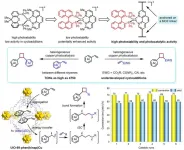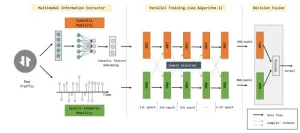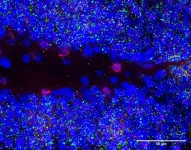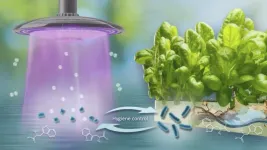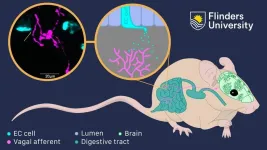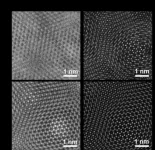(Press-News.org) Professor Jian HE, from the Department of Chemistry at The University of Hong Kong (HKU), has spearheaded a research endeavour aimed at revolutionising organic synthesis. His research team has successfully developed a novel heterogeneous copper photocatalyst that enables the efficient formation of cyclobutane rings, a crucial structural element in a vast array of bioactive molecules. Cyclobutane rings are prominently featured in pharmaceuticals, natural products, and various biologically active compounds. By enabling researchers to construct these rings easily and selectively, Professor He's team has unlocked greater control over the synthesis of these vital molecules. The research findings are recently published online in the top scientific journal Nature Catalysis.
In recent two decades, visible-light photocatalysts have been employed to drive such transformations through photochemical [2+2] cycloadditions; however, their substrate scope has been limited. Moreover, existing photocatalytic systems often rely on homogeneous precious metal catalysts, which pose challenges in catalyst recycling and hinder large-scale organic synthesis.
Addressing these limitations head-on, Professor He and his team have developed an innovative heterogeneous copper photocatalyst. This catalyst effectively facilitates energy-transfer processes for a range of intermolecular crossed [2+2] cycloadditions, including those previously inaccessible in conventional homogeneous photocatalysis. This new reaction system has excellent catalyst stability and recyclability, and it does not rely on precious metals, making it more economically and environmentally sustainable.
Professor He expressed great enthusiasm for the potential impact of this discovery, stating, ‘Our novel heterogeneous copper photocatalyst opens up new possibilities for synthesising bioactive molecules with enhanced efficiency and selectivity. By eliminating the reliance on precious metals and improving catalyst recyclability, we have addressed critical challenges in large-scale organic synthesis, paving the way for more sustainable and economically viable chemical production.’
Key findings
In this study, the team developed a special kind of copper photocatalyst that can help make cyclobutane molecules more efficiently. They successfully prepared a stable heterogeneous copper triplet photosensitiser by constructing binap-ligated heteroleptic copper(I) complexes in the pores of zirconium-based metal–organic frameworks (MOFs). Upon heterogenisation, reactive copper(I) species in photoexcited states show increased transition energies and lifetime, which is essential for boosting catalytic efficiency in energy-transfer-mediated [2+2] cycloadditions of styrenes with a variety of olefins, including electron-deficient alkenes. Unlike the corresponding homogeneous copper photocatalysts, the MOF-supported copper photocatalyst exhibits high stability and catalytic activity, and can be recycled multiple runs without catalyst decomposition. This work provides a general and interdisciplinary approach to designing highly reactive copper photocatalysts for a wide range of practical organic reactions, and it could help make the process of producing diverse bioactive compounds easier and more efficient in the future.
About Professor Jian He
Professor Jian He is an Assistant Professor in the Department of Chemistry and State Key Laboratory of Synthetic Chemistry at The University of Hong Kong. His independent research programme, at the interface between organic chemistry, inorganic chemistry, and materials science, is rooted in the design of novel framework- and cluster-based catalysts for the advancement of sustainable organic synthesis. He has received multiple awards, including The Alfred R. Bader Award for Student Innovation in 2014, International Precious Metals Institute Student Award in 2015, Reaxys PhD Prize Finalist in 2015, ACS Division of Organic Chemistry Travel Award in 2015, Chinese Government Award for Outstanding Self-Financed Students Abroad in 2015, IUPAC-Solvay Honorable Mention Prize in 2017, and Croucher Innovation Award in 2021.
About the Research Team
Dr Jun GUO and Mr Qi XIA from Professor HE’s group are the co-first authors. Other researchers, including Wing Yi TANG, Zekun LI, Xia WU, Li-Juan LIU, Wai-Pong TO, Hui-Xing SHU, Kam-Hung LOW, and Professor Philip C. Y. CHOW from HKU and Professor Tsz Woon Benedict LO from The Hong Kong Polytechnic University, contribute to this project.
Journal title: ‘Visible light-mediated intermolecular crossed [2+2] cycloadditions using a MOF-supported copper triplet photosensitizer’ (Nature Catalysis, 2024).
The journal paper can be accessed here: https://www.nature.com/articles/s41929-024-01112-9
Image and caption for download: https://www.scifac.hku.hk/press
For media enquiries, please contact Ms Casey To, External Relations Officer (tel: 39174948; email: caseyto@hku.hk / Ms Cindy Chan, Assistant Director of Communications of HKU Faculty of Science (tel: 3917 5286; email: cindycst@hku.hk).
END
HKU chemists pave the way for sustainable organic synthesis with innovative heterogeneous copper photocatalysis, enabling efficient production of diverse bioactive compounds
2024-02-27
ELSE PRESS RELEASES FROM THIS DATE:
Using multimodal deep learning to detect malicious traffic with noisy labels
2024-02-27
The success of a deep learning-based network intrusion detection systems (NIDS) relies on large-scale, labeled, realistic traffic. However, automated labeling of realistic traffic, such as by sand-box and rule-based approaches, is prone to errors, which in turn affects deep learning-based NIDS.
To solve the problems, a research team led by Yuefei ZHU published their new research on 15 Feb 2024 in Frontiers of Computer Science co-published by Higher Education Press and Springer Nature.
The team ...
Learning and memory problems in down syndrome linked to alterations in genome's ‘dark matter’
2024-02-27
Researchers at the Centre for Genomic Regulation (CRG) reveal that the Snhg11 gene is critical for the function and formation of neurons in the hippocampus. Experiments with mice and human tissues revealed the gene is less active in brains with Down syndrome, potentially contributing to the memory deficits observed in people living with the condition. The findings are published today in the journal Molecular Psychiatry.
Traditionally, much of the focus in genomics has been on protein-coding genes, which in humans constitutes around just 2% of the entire genome. The rest is "dark ...
Race, racism, and covid-19 in the US: lessons not learn
2024-02-27
In The BMJ today, Keisha Bentley-Edwards at Duke University, North Carolina, and colleagues argue that systemic racism and economic inequality are at the root of disparity in covid-19 outcomes and suggest how to distribute resources more equitably.
The article is part of a series that highlights the lessons that can be learned from the US’s covid-19 experience and the actions that are needed to prevent the loss of another million citizens in the next pandemic and improve and protect population health.
"Rather than waiting for the next pandemic to address systemic failures, the ...
Low-Temperature Plasma used to remove E. coli from hydroponically grown crops
2024-02-27
A group led by researchers at Nagoya University and Meijo University in Japan has developed a disinfection technology that uses low-temperature plasma generated by electricity to cultivate environmentally friendly hydroponically grown crops. This innovative technology sterilizes the crops, promoting plant growth without the use of chemical fertilizers. Their findings appeared in Environmental Technology & Innovations.
In hydroponic agriculture, farmers cultivate plants by providing their roots with a nutrient solution. However, the nutrient solution can become infected with pathogenic E. coli strains, contaminating the crop and leading to foodborne illnesses.
To avoid ...
UK cancer treatment falls behind other countries
2024-02-27
Two major studies part-funded by Cancer Research UK reveal that the use of chemotherapy and radiotherapy in the UK has lagged behind comparable countries in the past decade
Patients faced longer waits to begin key cancer treatment, which could be impacting people’s chances of survival in the UK
With an upcoming UK general election, Cancer Research UK is calling on political leaders to step up and ensure patients get the level of care that they deserve
People in the UK were treated with chemotherapy ...
Gut-brain communication turned on its axis
2024-02-27
The mechanisms by which antidepressants and other emotion-focused medications work could be reconsidered due to an important new breakthrough in the understanding of how the gut communicates with the brain.
New research led by Flinders University has uncovered major developments in understanding how the gut communicates with the brain, which could have a profound impact on the make-up and use of medications such as antidepressants.
“The gut-brain axis consists of complex bidirectional neural communication pathway between the brain and the gut, which links emotional and cognitive ...
NSF and DOE establish a Research Coordination Network dedicated to enhancing privacy research
2024-02-27
In response to the rapidly evolving landscape of data collection and analysis driven by advances in artificial intelligence, the U.S. National Science Foundation (NSF) and the U.S. Department of Energy (DOE) have established a Research Coordination Network (RCN) dedicated to advancing privacy research and the development, deployment and scaling of privacy enhancing technologies (PETs). Fulfilling a mandate from the "Executive Order on the Safe, Secure, and Trustworthy Development and Use of Artificial Intelligence," the initiative advances the recommendations in the National Strategy to Advance ...
Want to encourage allyship? Highlight its appreciation, research shows
2024-02-27
Allyship — the practice of relatively advantaged group members acting with the intention to support, advocate and improve circumstances for relatively disadvantaged groups — is critical to promoting more inclusive and equitable organizations.
Not only are advantaged group members typically received more favorably within an organization than disadvantaged group members would be when they speak out against injustice, their allyship can improve disadvantaged group members’ psychological experience in the organization. For instance, men are more likely to believe other men, compared with women, when they confront sexism. And Black Americans report higher levels of self-esteem ...
UM School of Medicine awarded $3.5 million in federal funding to expand medical countermeasures program
2024-02-26
University of Maryland School of Medicine (UMSOM) Dean Mark T. Gladwin, MD, announced today that UMSOM faculty scientists have been selected as key contractors by the Biomedical Advanced Research and Development Authority (BARDA), for the federal agency’s Radiation Nuclear Animal Model Development program. The $3.5 million award that Erika Davies, PhD, Assistant Professor of Radiation Oncology, received to develop Acute Radiation Syndrome Animal Models, has a $16 million potential total. The Division of Translational Radiation Sciences (DTRS), within the Department of Radiation Oncology, will support this project.
Dr. Davies and her colleagues ...
Reimagining electron microscopy: Bringing high-end resolution to lower-cost microscopes
2024-02-26
Researchers at the University of Illinois at Urbana-Champaign have shown for the first time that expensive aberration-corrected microscopes are no longer required to achieve record-breaking microscopic resolution.
The field of microscopy is in the middle of a great revolution. Since the 1800s and the invention of the compound light microscope, there have only been a few major jumps in resolution to see different length scales: from bacteria and cells, to viruses and proteins, and even down to single atoms. Generally, ...
